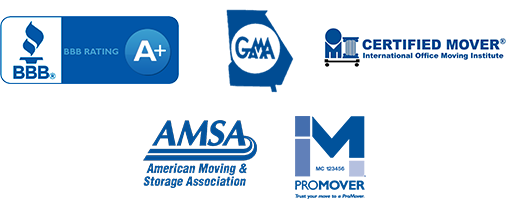If you choose to pack yourself, there are things that you should be aware of. Good packing is essential to a successful move. Becoming familiar with basic packing tips and the boxes that will assist you in being successful will ensure that your possessions are protected.
Packing Basics:
Your boxes should weigh less than 50 pounds to make moving easier. Limit the heavy items to smaller boxes and fill your larger boxes with light items.
Make sure that your breakable items are wrapped to ensure that they can not be broken during the move. Bubble wrap is a good method to use for these items.
Ensure that there is not a lot of extra space in your boxes. This is important to ensure that your items do not shift during the move.
Use boxes that are sturdy and have the ability to close and be secured.
Make sure that all boxes are labeled and that the items in each box are specific to a certain room in the home. This makes unpacking easier for you.
Tips For Starting Your Packing:
Begin by packing items in the house that you are not using. Things that you use daily should be packed last. This is also a good time to eliminate items from your home that have not been used in a long time.
Empty all heavy items from your drawers along with items that may spill during your move. Light items may remain in your drawers and can be moved in the drawers on moving day.
Pack all like items together. For example, if you are packing your curtains pack the rods and the rod fasteners with the curtains so that they can be easily reassembeled at the new location.
You will need a lot of crushed paper. Layer the bottom of boxes with crushed paper so that you have padding for your items. When a box is full, fill in the empty spaces with crushed paper to avoid the shifting of your valuables during a move.
Wrap your items in paper. For fine china and other delicate items, use double wrapping to ensure that your items are protected.
When packing boxes, load the heaviest items for that box on the bottom of the box. The lightest items should always be on the top of the box.
Pack your finest items in small boxes and then combine those into a larger box. Again, make sure that you use crushed paper to cushion between the boxes.
All of your delicate items will need extra cushioning and extra wrapping. When you think you have wrapped it enough, add another layer of wrapping just to be sure. These are the items in the most jeopardy during a move.
Do not overload boxes. Pick the right size box for the items that you are packing in it and remember that boxes should not weigh more than 50 pounds.
Whenever possible pack items in their original boxes. Remember that these boxes were made to fit the items that they originally carried. Again, remember to cushion these items if you do not have the original material that the items came packed in.
Do not seal your boxes until your moving consultant has had an opportunity to evaluate the packing on move day. If we are to be responsible for your precious items, it is critical that we make sure that the items are packed in such a way that they are as safe as they can be.
Label all boxes. Put the name of the room that they belong in, list the contents on the box, put your name on each box. When you get to your new home tape the name of the person that will be living in each room on the door of the room. This enables us to unload boxes to the appropriate persons space, thereby helping you unpack more efficiently. Mark the most important boxes that need to be unpacked first in a special way so that you will know them.
Packing Special Items: Fragile Items
Electronics
When possible, pack these items in their original boxes. If you do not have the boxes, contact a local electronic store and inquire about obtaining original boxes from them.
If you do not have original packing material we strongly suggest you allow us to pack these items for you. Electronics add a special wrinkle to your self packing project and we recommend investing the money it takes to ensure that these items are moved without damage. Packing these items yourself could result in damage during the move which could cost significantly more than hiring us to pack these items.
Figurines & Collectibles
Wrap all items in soft paper first and then wrap in newspaper or magazines. Make sure to include a lot of crushed paper around the items. This will reduce shifting during the move and do more to protect these fragile items.
Mirros, plaques, wall art can be wrapped in towels or blankets to add extra protection during the move. Glass is especially protected by towels or blankets. Place the items on the edge inside a box. Do not place on a corner or at an angle.
China & Glassware
Dish packs are essential in ensuring that your China is protected. You can get dish packs from Bulldog Movers. These dish packs are specifically designed to protect your China and unless you have similar boxes, do not pack these items yourself. The money that you can save packing your own China is not equal to the loss if they are not packed correctly.
Wrap each item individually and then double wrap them in newspaper. Start from a corner, wrap the item diagonally and continue to tuck in the overlapping edges. Make sure to use a lot of padding in extra paper as China requires a lot of cushion before being placed in a box. Also, remember to make a 2-3 inch pad of crushed paper on the bottom of the box.
Label each carton as FRAGILE. Also make sure to place a line of text indicating which side is up. These items will not be packed under any other boxes when loaded on the truck as long as the movers know from the label that they are fragile.
Large Platters, Glass Plates, etc.
Place crushed paper as a cushion on the bottom of the box first.
Select an appropriate box size to fit these larger items.
Wrap each piece individually and then wrap them in larger and softer materials like towels and blankets. Bundle these items together with another large towel or blanket.
Put the bundled items on top of the crushed material and then add additional crushed paper to surround the items and secure them in the box. Your movers have horizontal cardboard dividers which can be useful in packing and protecting these items. Ask your moving specialists for these items when you need them.
Smaller platters, bowls, and saucers can make up a second layer in these boxes as long as the weight of the box is not exceeding your limits. Pick the box up and see if they are getting too heavy before adding more items to the box. If it is still ok, add carefully wrapped serving bowls and smallers platters to take up the additional room in the box. Again, use your cardboard dividers for additional security of these important items.
Silver
Enclose all silver completely to avoid tarnish. Silver bowls, tea sets, and serving dishes should be wrapped in such a way that they empty spaces are full of material. Silver is fragile and can bend, filling the dead space can ensure that the items are not crushed during move.
Label all boxes as fragile and silver. This enables all boxes to be loaded properly in the moving truck.
If you are packing silver that is in a chest, wrap each piece within the chest to ensure they transport properly. Fill all empty spaces in the silver chest with crushed paper to avoid shifting during the move. Wrap the chest in a blanket or large towel.
Glass Table Tops, Large Mirrors, Paintings, Statues, Vases, etc.
These items, more than others, can be easily damaged due to their bulk. Rather than packing these items yourself, consult with your moving specialist at Bulldog Movers to pack these items for moving. We strongly recommend that you not pack these items yourself.
Oil paintings should never be touched with any kind of paper. Paper can damage the paint or adhere to the paint and therefor should never come in contact with any oil paintings.
Books
There are two ways to pack books. Either lay them flat on the bottom of the box or place them spine down inside the box. Most people tend to pack with the spines up but this can cause the glue to seperate from the spine of the book and ruin your books. Pack same size books together in the same box.
Expensive books or those of high sentimental value should be wrapped before packing.
Use smaller boxes for books to avoid exceeding the 50 pound maximum per box.
Pictures
Pack all pictures, slides, videos, negatives, etc in boxes seperate from other household items. Pack all picture albums in seperate boxes from the loose pictures.
Framed pictures should be wrapped to avoid having the glass broken.
Carry any items with you that can not be replaced if at all possible.
CD’s, Records, Tapes, DVD’s, VCR Tapes
Remove these items from any current storage that they may reside in. Records are heavier than you may think and should be packed in small boxes.
Records that are in their jackets can be individually wrapped and then bundled together with a blanket, sheet, or large towel before being placed in a box. Records that do not have a jacket need to be doubly wrapped before being bundled together for packing. Plastic wrap is the best first layer to avoid the record from being scratched.
Stand all records on their edge on top of a cushioned bottom. Never lay these items flat in a box. Pack additional crushed paper around the records to ensure that they stand up during transport and not shift to laying at an angle. Mark each box as fragile and record the contents on the outside of the box.
Pack CD’s and DVD’s in a similar manner that you pack records. Never lay them flat.
Cassette tapes should be in the plastic case that they came in. Wrap the case individually before placing them in the box. These items can be packed either vertically or horizontally. Just pack with crushed paper in between each layer.
VCR tapes should also be packed in the original case. If no case is available make sure that they are wrapped carefully before being loaded in the box. The type of material you choose to use for wrapping can make a difference with VCR tapes. Make sure that the plastic piece that covers the actual recorded images is in place. If the VCR tape is not replaceable, try to pack the tape with you.
Lamps & Lamp Shades
Remove the lamp shade, light bulb, and lamp harp (the part that sits over the light bulb and attaches the lamp shade to the lamp base) from the lamp base.
Never wrap lampshades in newspaper as it can discolor your lamp shade. Wrap each shade in 3-4 pieces of non-colored paper or in a pillow case or light towel. Smaller lamp shades can be nested inside larger ones. This should be done to conserve space and assist with the filling of dead space.
Line your box with clean paper. Use a box that is at least two inches larger around than the largest lamp shade that you have to pack. If your lamp shade is silk, pack it by itself.
Pack lamp shades by themselves and label the box as fragile – lamp shades.
If you have glass lamps, like tiffany style lamps, let Bulldog Movers crate these items for you. Chandeliers should also be crated by your moving company.
Non-Fragile Items
Rugs
Roll your rugs. It is best to have these items cleaned before moving. Leave them rolled and wrapped when you retrieve them from your cleaners.
Linens & Bedding
Linens can be protected by a large plastic bag and packed in a box lined with clean paper. It is recommended that you wash all linens before packing so that when you get to your new home you are unpacking clean items.
If you have delicate linens, wrap them before being packed.
Wrap your mattresses in plastic or special boxes. These are available from your moving company. Wrapping your mattress ensures that you do not get dirt, dust, and other materials inside your mattress fibers on move day.
Curtains, Drapes, & Table Cloths
Wardrobe boxes are the best way to move these items. Fold them and place over a padded hanger. Pin the items to the padded hanger and hang them in the warbrobe box.
You can fold these itmes and place them in boxes lined with clean paper (not newspaper) if you choose.
If you have them cleaned prior to move day, leave them wrapped in the cleaners plastic bag for packing.
Appliances
Small appliances should be wrapped individually and packed in a box lined with crushed paper.
Irons and other like items should be emptied of all water before being packed.
Remove all batteries from appliances before they are packed. Pack batteries in a seperate box for use at your new home.
Large appliance MUST be serviced before they can be moved. You can arrange this through a service technician or contact Bulldog Movers for assistance.
Garage Items & Outdoor Items (Tools, Lawn Equipment, Swing sets, TV Antennas, Garden Sheds, etc)
Dismantle all swingsets, sheds, TV antennas, etc. Gather the pieces together for those items and secure them with rope. Nylon is preferred. Place the hardware for these items in a bag and attach them to the bundled pieces.
Drain all fluids from lawn equipment before moving day. Gas and Oil can be hazardous on move day.
Long handled tools should be bundled together and secured with a nylon rope. Attachments should be removed from all long handled power tools and packed seperately. Make sure you label the box with what the attachments belong to for easier assembly at the new location.
Hand tools can be left in their tool boxes. Just fill the spaces with crushed paper to avoid shifting on move day. Use small boxes for tools as they tend to be heavy.
When in doubt, contact your moving specialist for assistance. If at any point during the self packing process you decide that you need help, Bulldog Movers can handle the rest of the move for you. Packing and moving can be a daunting process and we understand that better than anyone. Our years of experience are at your disposal.

















